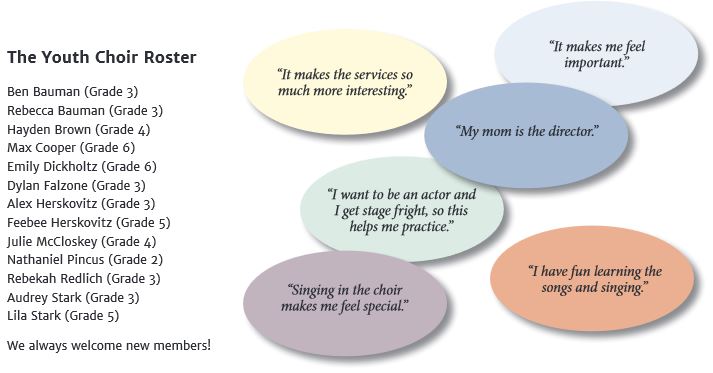Posted on May 4, 2017
What, you may ask, is “hidur mitzvah”? Cantor Emily Pincus tells us this is an expression that means “to make the mitzvah more beautiful.” In other words, out of the mitzvah of prayer, the singer creates an even greater mitzvah. This idea is at the heart of her goals for the youth choir, for both the children singing in the choir and the congregants enjoying their music.
You may have heard the new youth choir singing at the Tu B’shvat service, or at the festive Purim Spiel. Currently they are 12 members strong (see below), but new members are always welcome and encouraged. The choir will sing at the two remaining family services this year, on May 12 and June 9. And they recently sang at a community-wide Yom Ha-atzmaut celebration at the JCC on Sunday, April 30.
Through the children’s participation in the choir, Cantor Pincus hopes to encourage relationships between the kids and reinforce their connection to prayer, Judaism and synagogue life. “Rehearsals are not just straight singing,” she points out. “I do have certain musical standards that I want them to meet, but that’s actually not the primary goal.” What’s important is that the choir members are not only building their own Jewish identities; they are also serving as role models for other children. “Having a children’s choir sing at family services helps other children feel comfortable. They know this service is for them, and it makes it easier for them to relate to it.”
Through song, Cantor Pincus hopes to ground the choir members in regular Shabbat observance and to encourage them to “take pride in being one of the ‘makers.’” Explaining that in practice it’s often difficult for children (and even adults) to create their own prayer experience, she sees worship through song as an excellent avenue through which children can explore their spirituality and become active participants in the synagogue.
On a more personal level, Cantor Pincus enjoys getting to know the children better, conducting them at services and “helping them grow in musical confidence.” She herself was strongly influenced by her own experiences singing in children’s choir, and sees the act of singing as integral to building a strong connection to Judaism and Jewish identity. “When you sing certain prayers, you have them for life. I still remember the songs I learned in children’s choir when I was a kid. It was a direct connection for me with Shabbat liturgy,” she reflects. “I also learned that you could have more than one tune for the same text, and I began to understand the variety of Jewish musical expression that existed.” Her experience also gave her important perspective on balancing different aspects of her life. “I could sense how the sacred and the secular were woven together through music, and that you didn’t have to reject one in order to hold on to the other.”
As with any work in progress, there is plenty of fine-tuning going on. “One thing I have been experimenting with is how to have the choir participate but still understand how they fit into the larger scheme of the service, without disrupting the flow,” the cantor muses. The best solution so far is to have the children sing at the beginning and end of the service from the bimah, but return to their seats in the front row for the majority of it, “where they can sit comfortably and learn to be in their own prayer space during a service.”
What’s in the youth choir’s future? Cantor Pincus wants to put singing at assisted living facilities and nursing homes on the list for Mitzvah Day and over Chanukah or Pesach, ideally in conjunction with the adult choir, and to keep finding new opportunities to have these wonderful young voices lift us all up in song.

Originally published in the May-June 2017 issue of the Shofar. For more issues of the Shofar, visit the Shofar archives